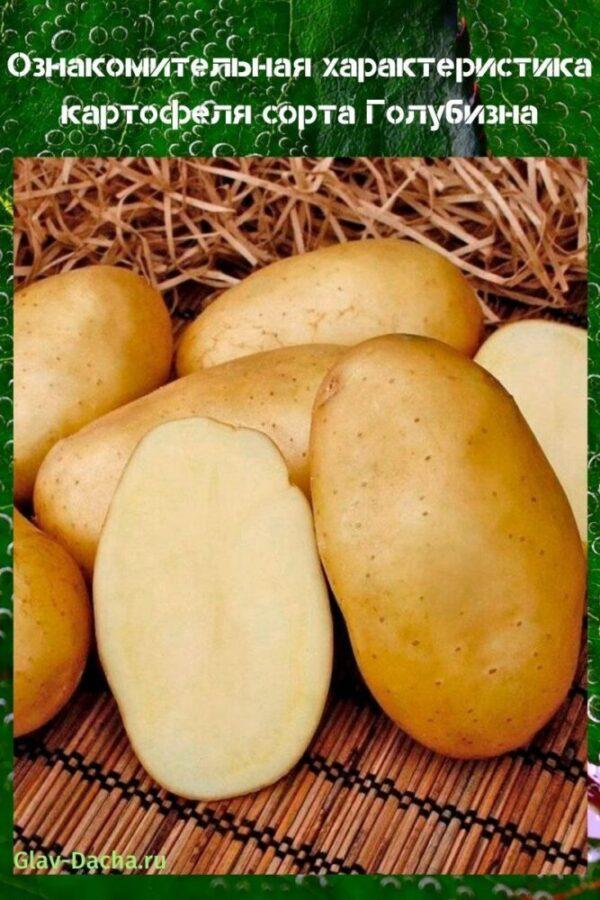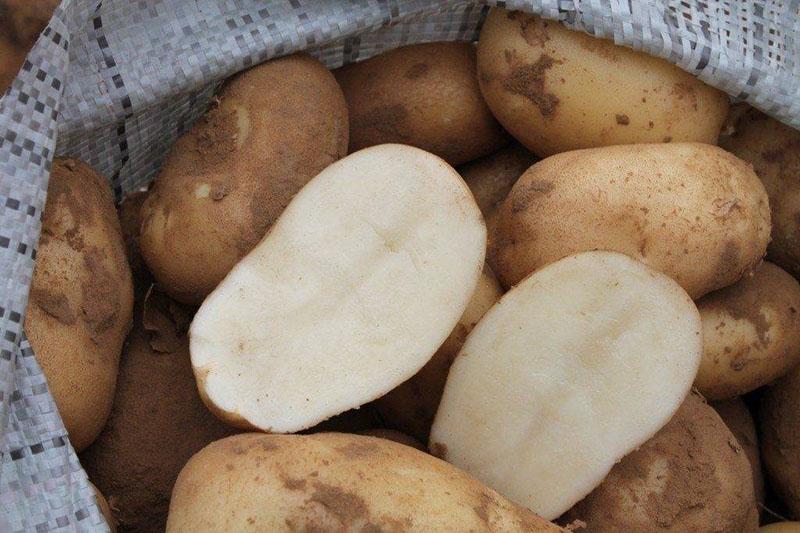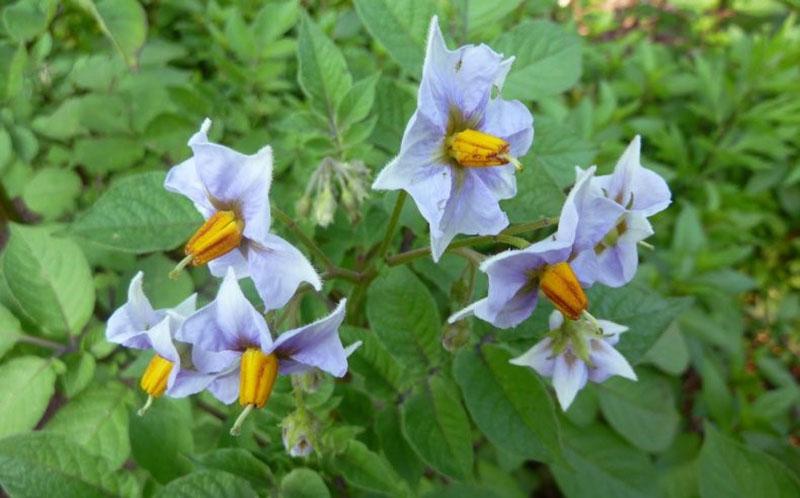Introductory characteristics of Golubizna potatoes
 Blueness is a popular potato variety that is resistant to diseases and sudden temperature changes, unpretentious care and high yields. When growing a crop, the characteristics of the Golubizna potato must be taken into account - this will help to get a generous potato crop.
Blueness is a popular potato variety that is resistant to diseases and sudden temperature changes, unpretentious care and high yields. When growing a crop, the characteristics of the Golubizna potato must be taken into account - this will help to get a generous potato crop.
Characteristics of blue potatoes


Description of potatoes Blueness:
- A potato bush of medium height, not spreading, with compact, rounded tops.
- The leaves are large, dark green, with a slight bluish tint.
- Inflorescences are deep bluish-blue. The flowering period lasts up to 15 days.
- The vegetative period lasts from 95 to 115 days.
- Potato tubers are round or slightly oblong, with small eyes. The peel is mesh, light beige, the flesh is creamy.
One of the characteristics of the characteristic of the potato variety Blueness is its high yield. Each bush gives 9-12 large tubers, the average weight of which is 80-110 g. From one hectare of potato plantations, up to 46-50 tons of harvest can be obtained.
Growing potatoes Blue
 Blue is a versatile potato variety intended for cultivation in all regions of Russia. When choosing the optimal timing for planting, the characteristic of blue seed potatoes, as well as the peculiarities of climatic conditions, must be taken into account.
Blue is a versatile potato variety intended for cultivation in all regions of Russia. When choosing the optimal timing for planting, the characteristic of blue seed potatoes, as well as the peculiarities of climatic conditions, must be taken into account.
In Central Russia, plant Golubizna potatoes in the first days of May, when the soil warms up to + 7 ° С. With prolonged warm weather, planting work can be carried out in the second half of April.
Soil selection

The best option for planting blue potatoes is sandy loam or loamy soil. The variety has good adaptive qualities, so it can be grown on other types of soil.
Preparation of the soil should be started in advance, around the end of August or the beginning of September. To do this, dig up the selected area to a depth of 20-25 cm, then add rotted manure (10 kg per 1 sq. M.).
At the end of April, before planting, the soil must be re-dug up and fertilized. superphosphate - 500 g per 1 sq. M.
Preparation of planting material
 Tubers selected during harvest are used as planting material. They should be healthy, free from rot and damage, about the same size. Seed can be germinated 6 weeks before planting.
Tubers selected during harvest are used as planting material. They should be healthy, free from rot and damage, about the same size. Seed can be germinated 6 weeks before planting.
First, sort out the potatoes, remove all spoiled and rotten tubers. After that, pour them into wooden boxes in one layer and store in a well-lit room at an air temperature of up to + 19 ° C.
After about 20 days, a slight greenish tint appears on the surface of the tubers, shoots sprout from the eyes. Moisten the potatoes, cover with plastic wrap and leave for another week. When the sprouts are at least 2 cm in size, you can start planting.
Planting potatoes step by step
 For planting potatoes, prepare holes, the size of which should be 10-15 cm.The distance between the pits is about 30-40 cm, leave 50 cm between the rows.
For planting potatoes, prepare holes, the size of which should be 10-15 cm.The distance between the pits is about 30-40 cm, leave 50 cm between the rows.
Planting potatoes step by step:
- add a spoonful of dry chicken manure or 2 tablespoons to each well wood ash - it will enrich the soil and protect it from pests;
- place 2-3 potatoes in each hole - the sprouts should be directed up;
- sprinkle the holes with soil and level with a rake.
Large potatoes can be cut into several smaller pieces before planting. This will increase the yield of blue potatoes.
Potato care Blue
 When caring for plantings, it is necessary to take into account the characteristics of the Blueness potato variety, providing it with regular watering, feeding, disease prevention and timely pest control. Weeding and weeding are also important.
When caring for plantings, it is necessary to take into account the characteristics of the Blueness potato variety, providing it with regular watering, feeding, disease prevention and timely pest control. Weeding and weeding are also important.
Watering
 Planting and caring for Golubizna potatoes is not particularly difficult, so it is popular among novice gardeners. The tubers do not need regular watering - it is enough to irrigate the beds 3-4 times during the entire growing season. During the summer drought, the amount of water increases to 3-4 liters for each bush.
Planting and caring for Golubizna potatoes is not particularly difficult, so it is popular among novice gardeners. The tubers do not need regular watering - it is enough to irrigate the beds 3-4 times during the entire growing season. During the summer drought, the amount of water increases to 3-4 liters for each bush.
For blueness potatoes, both a lack and an excess of moisture are dangerous. In the first case, the tubers begin to sink into the ground, so digging them up is quite problematic. In the second, viral or fungal diseases develop.
Top dressing
 The first feeding of potatoes is carried out before planting. The second - during the active growing season. You can determine that a plant needs fertilization by dryness, weakness and lethargy of the shoots. In such cases, potatoes can be fed with urea - add 20 g of the drug under each bush.
The first feeding of potatoes is carried out before planting. The second - during the active growing season. You can determine that a plant needs fertilization by dryness, weakness and lethargy of the shoots. In such cases, potatoes can be fed with urea - add 20 g of the drug under each bush.
An ash solution is added to stimulate flowering. To prepare it, pour 500 g of ash into a bucket of water, boil for half an hour and mix with 3 liters of clean water. Water the potato bushes with the resulting solution at the rate of 2 liters for each plant.
Hilling and weeding
 Hilling of potatoes is carried out immediately after the first shoots appear. This is necessary so that the plant's root system can retain moisture and protect it from frost.
Hilling of potatoes is carried out immediately after the first shoots appear. This is necessary so that the plant's root system can retain moisture and protect it from frost.
Weeding the beds is carried out regularly. It not only helps to get rid of weeds, but also prevents pests that live in weeds from attacking bushes.
 Potatoes Blueness attracts the attention of gardeners with its high yield, resistance to temperature extremes, a strong immune system and good taste characteristics of tubers. This variety is unpretentious in maintenance and gives a rich harvest even on scarce soils without regular watering.
Potatoes Blueness attracts the attention of gardeners with its high yield, resistance to temperature extremes, a strong immune system and good taste characteristics of tubers. This variety is unpretentious in maintenance and gives a rich harvest even on scarce soils without regular watering.